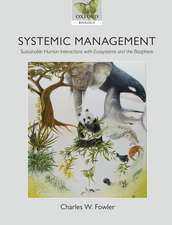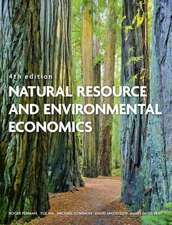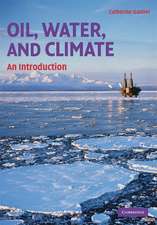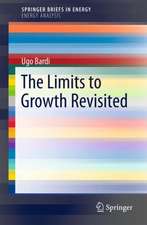Social and Ecological System Dynamics: Characteristics, Trends, and Integration in the Lake Tana Basin, Ethiopia: AESS Interdisciplinary Environmental Studies and Sciences Series
Editat de Krystyna Stave, Goraw Goshu, Shimelis Aynalemen Limba Engleză Hardback – 13 apr 2017
| Toate formatele și edițiile | Preț | Express |
|---|---|---|
| Paperback (1) | 662.31 lei 38-44 zile | |
| Springer International Publishing – 18 iul 2018 | 662.31 lei 38-44 zile | |
| Hardback (1) | 1141.02 lei 22-36 zile | |
| Springer International Publishing – 13 apr 2017 | 1141.02 lei 22-36 zile |
Preț: 1141.02 lei
Preț vechi: 1391.49 lei
-18% Nou
Puncte Express: 1712
Preț estimativ în valută:
218.34€ • 228.54$ • 181.72£
218.34€ • 228.54$ • 181.72£
Carte disponibilă
Livrare economică 10-24 martie
Preluare comenzi: 021 569.72.76
Specificații
ISBN-13: 9783319457536
ISBN-10: 3319457535
Pagini: 479
Ilustrații: XVII, 652 p. 95 illus., 73 illus. in color.
Dimensiuni: 155 x 235 x 43 mm
Greutate: 1.37 kg
Ediția:1st ed. 2017
Editura: Springer International Publishing
Colecția Springer
Seria AESS Interdisciplinary Environmental Studies and Sciences Series
Locul publicării:Cham, Switzerland
ISBN-10: 3319457535
Pagini: 479
Ilustrații: XVII, 652 p. 95 illus., 73 illus. in color.
Dimensiuni: 155 x 235 x 43 mm
Greutate: 1.37 kg
Ediția:1st ed. 2017
Editura: Springer International Publishing
Colecția Springer
Seria AESS Interdisciplinary Environmental Studies and Sciences Series
Locul publicării:Cham, Switzerland
Cuprins
SECTION I: Overview.- 1. Introduction: Regional Challenges and Policy Questions.- 2. Problem Overview of the Lake Tana Basin.- 3. System Dynamics as a Framework for Understanding Human—Environment Dynamics.- 4. Bahir Dar and the Lake Tana Basin: Historical Phases of Growth and Ecology. SECTION II: Ecosystem Characteristics.- 5. Climate of Lake Tana Basin. 6. Temporal and spatial climate variability and trends over Abay (Blue Nile) river basin.- 7. Overview of the hydrogeology and groundwater occurrence in the Lake Tana basin, Upper Blue Nile river basin.- 8. Characterization, Classification and Mapping of Soils of Agricultural landscape in Tana basin, Amhara National Regional State, Ethiopia.- 9. Hydrology of Lake Tana Basin.- 10.- Water quality of Lake Tana basin, Upper blue Nile, Ethiopia: A review of available data.- 11. Plankton of Lake Tana.- 12.- The Fish and the Fisheries of Lake Tana.- 13. Birds of Lake Tana Sub-Basin.- 14. Herpetofauna and Mammals.- 15. Forest Resources in Amhara: Brief Description, Distribution and Status.- 16. Wetlands of the Lake Tana watershed.- 17. Exotic and Invasive plants: Water hyacinth.- SECTION III: Socioeconomic System Characteristics and Land Use.- 18.Demographic Characteristics of the Lake Tana Basin.- 19. Gender and Rural Livelihood in the Lake Tana Basin.- 20. Examining the characteristics of stakeholders in Lake Tana Sub-basin resource use, management and Governance.- 21. Lake Tana Subbasin's Economy and The Role of Natural Resources.- 22.Land Use Distribution and Change in Lake Tana Sub Basin.- 23. Agriculture in the Lake Tana Sub-Basin of Ethiopia.- 24. Challenges and opportunities for increasing farm animal productivity in the Lake Tana Basin.- 25. Urban Areas in the Lake Tana Region.- SECTION IV: Management.- 26. Environmental Protection in the Lake Tana Basin.- 27. Institutional Analysis of Environmental Resource Management in Lake Tana Sub- Basin.- 28. Land use and watershed management practices in Lake Tana basin.- 29. Establishment of the Lake Tana Biosphere Reserve within the UNESCO World Network of Biosphere Reserves.- 30. Water -Induced Shift of Farming Systems and Value Addition in Lake Tana Sub-Basin: The Case of Rice Production and Marketing in Fogera District, Northwestern Ethiopia.- 31. Trends and driving forces of eucalyptus plantation by smallholders in the Lake Tana Watershed of Ethiopia.- 32. Waste management in Lake Tana basin - Case of rapidly urbanizing Bahir Dar city.- SECTION V: Synthesis.- 33. Problems, Efforts and Future Directions of Natural Resources Management in Western Amhara Region of the Blue Nile Basin, Ethiopia: Review.- 34. Participatory System Dynamics Mapping for Collaboration and Socioecological Integration in the Lake Tana Region.
Notă biografică
Krystyna Stave, Ph.D., Professor University of Nevada Las Vegas, USA
Goraw Goshu, Director, Blue Nile Water Institute, Bahir Dar, Ethiopia
Shimelis Aynalem, Research Associate, Blue Nile Water Institute, Bahir Dar, Ethiopia
Textul de pe ultima copertă
This book is a social—ecological system description and feedback analysis of the Lake Tana Basin, the headwater catchment of the Upper Blue Nile River. This basin is an important local, national, and international resource, and concern about its sustainable development is growing at many levels. Lake Tana Basin outflows of water, sediments, nutrients, and contaminants affect water that flows downstream in the Blue Nile across international boundaries into the Nile River; the lake and surrounding land have recently been designated a UNESCO Biosphere Reserve; the basin has been identified as a key national economic growth corridor in the Ethiopian Growth and Transformation Plan. In spite of the Lake Tana Basin’s importance, there is no comprehensive, integrated, system-wide description of its characteristics and dynamics that can serve as a basis for its sustainable development. This book presents both the social and ecological characteristics of the region and an integrated, system-wide perspective of the feedback links that shape social and ecological change in the basin. Finally, it summarizes key research needs for sustainable development.
The Lake Tana Basin is the most economically, historically, and environmentally important subbasin of the Upper Blue Nile River System. Three million people live in this headwater catchment area, most in rural areas but increasingly migrating to urban settlements, including the cities of Bahir Dar and Gondar. The region is experiencing significant population, economic, ecosystem, and social change. Urbanization, intensification of rural land use, environmental degradation, and climate change are some of the pressures that require research-based management and policy action to protect resources and promote healthy development.
There are many researchers and decision-makers focusing on the region. However, research efforts are fragmented and are often not visible or useful to decision-makers. This book addresses theneed for a coordinated approach to understanding and managing this complex social—ecological system.
The Lake Tana Basin is the most economically, historically, and environmentally important subbasin of the Upper Blue Nile River System. Three million people live in this headwater catchment area, most in rural areas but increasingly migrating to urban settlements, including the cities of Bahir Dar and Gondar. The region is experiencing significant population, economic, ecosystem, and social change. Urbanization, intensification of rural land use, environmental degradation, and climate change are some of the pressures that require research-based management and policy action to protect resources and promote healthy development.
There are many researchers and decision-makers focusing on the region. However, research efforts are fragmented and are often not visible or useful to decision-makers. This book addresses theneed for a coordinated approach to understanding and managing this complex social—ecological system.
Caracteristici
Contributes to the theoretical literature about how to understand social-ecological system dynamics Presents both the social and ecological characteristics of the region and an integrated, system-wide perspective of the feedback links that shape social and ecological change in the basin Analyzes what is known about the basin in the context of the system’s issues, feedback mechanisms, and trends Includes supplementary material: sn.pub/extras




















